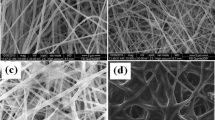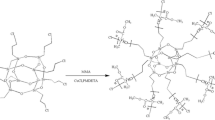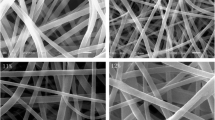Abstract
Polyhedral oligomeric silsesquioxane-poly(methyl methacrylate)8 (POSS-PMMA8)/polyvinylidene fluoride (PVDF) hybrid gel polymer electrolyte (HGPE) membranes have been fabricated by using electrospinning along with the use of commercial polypropylene (PP) microporous membranes as its support; the corresponding HGPEs were obtained after being activated into liquid electrolytes. The goal of the study is to incorporate the high mechanical property of microporous PP membrane and superior electrochemical performance of electrospun gel polymer electrolyte to get the high-performance electrolyte for Li-ion battery. As an effective modifier, it is found that the introduction of POSS-polymer plays a vital role in enhancing many properties of HGPEs, and the influence of POSS-(PMMA46)8 content on overall properties of HGPEs is investigated. In specific, the HGPEs membrane with 12 wt% POSS-(PMMA46)8 displays a significant uniform fiber diameter with 720 nm and high electrolyte uptake of 322% due to the high porosity of 58%. Meanwhile, a great improvement in mechanical property is obtained with a tensile strength of 34.5 MPa, which is about 7 times of POSS-(PMMA46)8/PVDF membrane without support. The interfacial resistance between the corresponding HGPEs and Li electrodes is significantly reduced and as low as 138 Ω. Furthermore, the LiFePO4/HGPEs/Li button cell is assembled and excellent cyclability is shown at 0.1 C and 0.5 C, respectively. The results demonstrate that POSS-(PMMA46)8/PVDF HGPEs could be applied as a promising HGPE candidate for high-performance Li-ion batteries.









Similar content being viewed by others
References
Lee H, Yanilmaz M, Toprakci O, Fu K, Zhang XW (2014) A review of recent developments in membrane separators for rechargeable lithium-ion batteries. Energy Environ Sci 7(12):3857–3886. https://doi.org/10.1039/c4ee01432d
Zhou GM, Li F, Cheng HM (2014) Progress in flexible lithium batteries and future prospects. Energy Environ Sci 7(4):1307–1338. https://doi.org/10.1039/c3ee43182g
Wang YX, Liu B, Li QY, Cartmell S, Ferrara S, Deng ZQD, Xiao J (2015) Lithium and lithium ion batteries for applications in microelectronic devices: a review. J Power Sources 286:330–345. https://doi.org/10.1016/j.jpowsour.2015.03.164
Lu QW, He YB, Yu QP, Li BH, Kaneti YV, Yao YW, Kang FY, Yang QH (2017) Dendrite-free, high-rate, long-life lithium metal batteries with a 3D cross-linked network polymer electrolyte. Adv Mater 29(13):1604460. https://doi.org/10.1002/adma.201604460
Pan QY, Chen YZ, Zhang YF, Zeng DL, Sun YB, Cheng HS (2016) A dense transparent polymeric single ion conductor for lithium ion batteries with remarkable long-term stability. J Power Sources 336:75–82. https://doi.org/10.1016/j.jpowsour.2016.10.033
Pieczonka NPW, Borgel V, Ziv B, Leifer N, Dargel V, Aurbach D, Kim J-H, Liu Z, Huang X, Krachkovskiy SA, Goward GR, Halalay I, Powell BR, Manthiram A (2015) Lithium polyacrylate (LiPAA) as an advanced binder and a passivating agent for high-voltage li-ion batteries. Adv Energy Mater 5(23):1501008. https://doi.org/10.1002/aenm.201501008
Choudhury S, Mangal R, Agrawal A, Archer LA (2015) A highly reversible room-temperature lithium metal battery based on crosslinked hairy nanoparticles. Nat Commun 6:10101. https://doi.org/10.1038/ncomms10101
Hu P, Zhao JH, Wang TS, Shang CQ, Zhang JN, Qin BS, Liu ZH, Xiong JW, Cui GL (2015) A composite gel polymer electrolyte with high voltage cyclability for Ni-rich cathode of lithium-ion battery. Electrochem Commun 61:32–35. https://doi.org/10.1016/j.elecom.2015.09.026
Park SR, Jung YC, Shin WK, Ahn KH, Lee CH, Kim DW (2017) Cross-linked fibrous composite separator for high performance lithium-ion batteries with enhanced safety. J Membr Sci 527:129–136. https://doi.org/10.1016/j.memsci.2017.01.015
Vondrák J, Sedlaříková M, Libich J, Jahn M (2017) Insights on electrochemical properties of gel polymer electrolytes based on methylmethacrylate. J Solid State Electrochem 21(9):2615–2620. https://doi.org/10.1007/s10008-017-3563-x
Hu P, Chai J, Duan Y, Liu Z, Cui G, Chen L (2016) Progress in nitrile-based polymer electrolytes for high performance lithium batteries. J Mater Chem A 4(26):10070–10083. https://doi.org/10.1039/c6ta02907h
Prasanth R, Aravindan V, Srinivasan M (2012) Novel polymer electrolyte based on cob-web electrospun multi component polymer blend of polyacrylonitrile/poly(methyl methacrylate)/polystyrene for lithium ion batteries—preparation and electrochemical characterization. J Power Sources 202(1):299–307. https://doi.org/10.1016/j.jpowsour.2011.11.057
Yan lmaz M, Sarac AS (2014) A review: effect of conductive polymers on the conductivities of electrospun mats. Text Res J 84(12):1325–1342. https://doi.org/10.1177/0040517513495943
Yanilmaz M, Chen C, Zhang X (2013) Fabrication and characterization of SiO 2 /PVDF composite nanofiber-coated PP nonwoven separators for lithium-ion batteries. J Polym Sci B Polym Phys 51(23):1719–1726. https://doi.org/10.1002/polb.23387
Yanilmaz M, Lu Y, Dirican M, Fu K, Zhang X (2014) Nanoparticle-on-nanofiber hybrid membrane separators for lithium-ion batteries via combining electrospraying and electrospinning techniques. J Membr Sci 456(456):57–65. https://doi.org/10.1016/j.memsci.2014.01.022
Jung JW, Lee CL, Yu S, Kim ID (2016) Electrospun nanofibers as a platform for advanced secondary batteries: a comprehensive review. J Mater Chem A 4(3):703–750. https://doi.org/10.1039/c5ta06844d
Mehdi A, Cerclier CV, Le Bideau J, Guyomard D, Dalmas F, Chenal JM, Chazeau L, Fontaine O, Vioux A (2017) PEO-Silsesquioxane flexible membranes: organic-inorganic solid electrolytes with controlled homogeneity and nanostructure. Chemistryselect 2(6):2088–2093. https://doi.org/10.1002/slct.201601798
Huang XY, Zeng SS, Liu JJ, He T, Sun LY, Xu DH, Yu XY, Luo Y, Zhou WY, Wu JF (2015) High-performance electrospun poly(vinylidene fluoride)/poly(propylene carbonate) gel polymer electrolyte for lithium-ion batteries. J Phys Chem C 119(50):27882–27891. https://doi.org/10.1021/acs.jpcc.5b09130
Lee H, Alcoutlabi M, Watson JV, Zhang XW (2013) Polyvinylidene fluoride-co-chlorotrifluoroethylene and polyvinylidene fluoride-co-hexafluoropropylene nanofiber-coated polypropylene microporous battery separator membranes. J Polym Sci Polym Phys 51(5):349–357. https://doi.org/10.1002/polb.23216
Lee YY, Liu YL (2017) Crosslinked electrospun poly(vinylidene difluoride) fiber mat as a matrix of gel polymer electrolyte for fast-charging lithium-ion battery. Electrochim Acta 258:1329–1335. https://doi.org/10.1016/j.electacta.2017.11.191
Snehashis C, Rahul M, Akanksha A, Archer LA (2015) A highly reversible room-temperature lithium metal battery based on crosslinked hairy nanoparticles. Nat Commun 6:10101. https://doi.org/10.1038/ncomms10101
Long L, Wang S, Xiao M, Meng Y (2016) Polymer electrolytes for lithium polymer batteries. J Mater Chem A 4(26):10038–10069
Fu QS, Lin G, Chen XD, Yu ZX, Yang RS, Li MT, Zeng XG, Chen J (2018) Mechanically reinforced PVdF/PMMA/SiO2 composite membrane and its electrochemical properties as a separator in lithium-ion batteries. Energy Technol 6(1):144–152. https://doi.org/10.1002/ente.201700347
Wu DZ, Deng L, Sun Y, Teh KS, Shi C, Tan QL, Zhao JB, Sun DH, Lin LW (2017) A high-safety PVDF/Al2O3 composite separator for Li-ion batteries via tip-induced electrospinning and dip-coating. RSC Adv 7(39):24410–24416. https://doi.org/10.1039/c7ra02681a
Kuilla T, Bhadra S, Yao D, Kim NH, Bose S, Lee JH (2010) Recent advances in graphene based polymer composites. Prog Polym Sci 35(11):1350–1375. https://doi.org/10.1016/j.progpolymsci.2010.07.005
Kim H, Park KY, Cho MY, Kim MH, Hong J, Jung SK, Roh KC, Kang K (2014) High-performance hybrid supercapacitor based on graphene-wrapped Li4Ti5O12 and activated carbon. Chemelectrochem 1(1):125–130. https://doi.org/10.1002/celc.201300186
Shim J, Kim HJ, Kim BG, Kim YS, Kim DG, Lee JC (2017) 2D boron nitride nanoflakes as a multifunctional additive in gel polymer electrolytes for safe, long cycle life and high rate lithium metal batteries. Energy Environ Sci 10(9):1911–1916. https://doi.org/10.1039/c7ee01095h
Liu YW, Peng XX, Cao Q, Jing B, Wang XY, Deng YY (2017) Gel polymer electrolyte based on poly(vinylidene fluoride)/thermoplastic polyurethane/polyacrylonitrile by the electrospinning technique. J Phys Chem C 121(35):19140–19146. https://doi.org/10.1021/acs.jpcc.7b03411
Kang WM, Ma XM, Zhao HH, Ju JG, Zhao YX, Yan J, Cheng BW (2016) Electrospun cellulose acetate/poly(vinylidene fluoride) nanofibrous membrane for polymer lithium-ion batteries. J Solid State Electrochem 20(10):2791–2803. https://doi.org/10.1007/s10008-016-3271-y
Liu Y, Ma XY, Sun K, Yang KQ, Chen F (2018) Preparation and characterization of gel polymer electrolyte based on electrospun polyhedral oligomeric silsesquioxane-poly(methyl methacrylate)(8)/polyvinylidene fluoride hybrid nanofiber membranes for lithium-ion batteries. J Solid State Electrochem 22(2):581–590. https://doi.org/10.1007/s10008-017-3761-6
Yang K, Ma X, Sun K, Liu Y, Chen F (2017) Electrospun octa(3-chloropropyl)-polyhedral oligomeric silsesquioxane-modified polyvinylidene fluoride/poly(acrylonitrile)/poly(methylmethacrylate) gel polymer electrolyte for high-performance lithium ion battery. J Solid State Electrochem 22(2):441–452. https://doi.org/10.1007/s10008-017-3758-1
Zhang F, Guan XH, Ma XY, Chen F, Qu FJ (2015) Effect of POSS star-shaped polymers on the properties of PMMA-based GPE. Acta Polym Sin 7:852–857
Weng B, Xu F, Alcoutlabi M, Mao Y, Lozano K (2015) Fibrous cellulose membrane mass produced via forcespinning® for lithium-ion battery separators. Cellulose 22(2):1311–1320. https://doi.org/10.1007/s10570-015-0564-8
Li XY, Cao Q, Wang XY, Jiang SH, Deng HY, Wu N (2011) Preparation of poly(vinylidene fluoride)/poly(methyl methacrylate) membranes by novel electrospinning system for lithium ion batteries. J Appl Polym Sci 122(4):2616–2620. https://doi.org/10.1002/app.34401
Ma Y, Ma J, Chai J, Liu Z, Ding G, Xu G, Liu H, Chen B, Zhou X, Cui G, Chen L (2017) Two players make a formidable combination: in situ generated poly(acrylic anhydride-2-methyl-acrylic acid-2-oxirane-ethyl ester-methyl methacrylate) cross-linking gel polymer electrolyte toward 5 V high-voltage batteries. ACS Appl Mater Interfaces 9(47):41462–41472. https://doi.org/10.1021/acsami.7b11342
Yanilmaz M, Zhang XW (2015) Polymethylmethacrylate/polyacrylonitrile membranes via centrifugal spinning as separator in li-ion batteries. Polymers 7(4):629–643. https://doi.org/10.3390/polym7040629
Peng XX, Zhou L, Jing B, Cao Q, Wang XY, Tang XL, Zeng J (2016) A high-performance electrospun thermoplastic polyurethane/poly(vinylidene fluoride-co-hexafluoropropylene) gel polymer electrolyte for Li-ion batteries. J Solid State Electrochem 20(1):255–262. https://doi.org/10.1007/s10008-015-3030-5
Dong Z, Kennedy SJ, Wu Y (2011) Electrospinning materials for energy-related applications and devices. J Power Sources 196(11):4886–4904. https://doi.org/10.1016/j.jpowsour.2011.01.090
Ma T, Cui ZY, Wu Y, Qin SH, Wang H, Yan F, Han N, Li JX (2013) Preparation of PVDF based blend microporous membranes for lithium ion batteries by thermally induced phase separation: I. Effect of PMMA on the membrane formation process and the properties. J Membr Sci 444:213–222. https://doi.org/10.1016/j.memsci.2013.05.028
Chai JC, Liu ZH, Zhang JJ, Sun JR, Tian ZY, Ji YY, Tang K, Zhou XH, Cui GL (2017) A superior polymer electrolyte with rigid cyclic carbonate backbone for rechargeable lithium ion batteries. ACS Appl Mater Interfaces 9(21):17897–17905. https://doi.org/10.1021/acsami.7b02844
He ZY, Cao Q, Jing B, Wang XY, Deng YY (2017) Gel electrolytes based on poly(vinylidenefluoride-co-hexafluoropropylene)/thermoplastic polyurethane/poly(methyl methacrylate) with in situ SiO2 for polymer lithium batteries. RSC Adv 7(6):3240–3248. https://doi.org/10.1039/c6ra25062a
Zhou XH, Yue LP, Zhang JJ, Kong QS, Liu ZH, Yao JH, Cui GL (2013) A core-shell structured polysulfonamide-based composite nonwoven towards high power lithium ion battery separator. J Electrochem Soc 160(9):A1341–A1347. https://doi.org/10.1149/2.003309jes
Salian GD, Lebouin C, Demoulin A, Lepihin MS, Maria S, Galeyeva AK, Kurbatov AP, Djenizian T (2017) Electrodeposition of polymer electrolyte in nanostructured electrodes for enhanced electrochemical performance of thin-film Li-ion microbatteries. J Power Sources 340:242–246. https://doi.org/10.1016/j.jpowsour.2016.11.078
Flora XH, Ulaganathan M, Rajendran S (2012) Influence of lithium salt concentration on PAN-PMMA blend polymer electrolytes. Int J Electrochem Sci 7(8):7451–7462
Bachman JC, Muy S, Grimaud A, Chang HH, Pour N, Lux SF, Paschos O, Maglia F, Lupart S, Lamp P (2016) Inorganic solid-state electrolytes for lithium batteries: mechanisms and properties governing ion conduction. Chem Rev 47(12):140–162. https://doi.org/10.1021/acs.chemrev.5b00563
Cui YY, Chai JC, Du HP, Duan YL, Xie GW, Liu ZH, Cui GL (2017) Facile and reliable in situ polymerization of poly(ethyl cyanoacrylate)-based polymer electrolytes toward flexible lithium batteries. ACS Appl Mater Interfaces 9(10):8737–8741. https://doi.org/10.1021/acsami.6b16218
Yanilmaz M, Chen C, Zhang XW (2013) Fabrication and characterization of SiO2/PVDF composite nanofiber-coated PP nonwoven separators for lithium-ion batteries. J Polym Sci Polym Phys 51(23):1719–1726. https://doi.org/10.1002/polb.23387
Xu RJ, Huang XR, Lin XG, Cao J, Yang JF, Lei CH (2017) The functional aqueous slurry coated separator using polyvinylidene fluoride powder particles for Lithium-ion batteries. J Electroanal Chem 786:77–85. https://doi.org/10.1016/j.jelechem.2017.01.016
Fang LF, Shi JL, Zhu BK, Zhu LP (2013) Facile introduction of polyether chains onto polypropylene separators and its application in lithium ion batteries. J Membr Sci 448:143–150. https://doi.org/10.1016/j.memsci.2013.07.065
Li XF, He JL, Wu DZ, Zhang MZ, Meng JW, Ni PH (2015) Development of plasma-treated polypropylene nonwoven-based composites for high-performance lithium-ion battery separators. Electrochim Acta 167:396–403. https://doi.org/10.1016/j.electacta.2015.03.188
Cai HP, Tong X, Chen K, Shen YF, Wu JS, Xiang YY, Wang Z, Li JS (2018) Electrospun polyethylene terephthalate nonwoven reinforced polypropylene separator: scalable synthesis and its lithium ion battery performance. Polymers 10(6). https://doi.org/10.3390/polym10060574
Funding
This research is financially supported by the Science and Technology Coordination Innovation Project in Shaanxi Province (Grant No. 2016KTZDGY10-01).
Author information
Authors and Affiliations
Corresponding author
Rights and permissions
About this article
Cite this article
Zhang, M., Ma, X., Liu, Y. et al. High-performance electrospun POSS-(PMMA46)8/PVDF hybrid gel polymer electrolytes with PP support for Li-ion batteries. Ionics 25, 2595–2605 (2019). https://doi.org/10.1007/s11581-018-2749-2
Received:
Revised:
Accepted:
Published:
Issue Date:
DOI: https://doi.org/10.1007/s11581-018-2749-2




